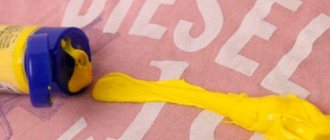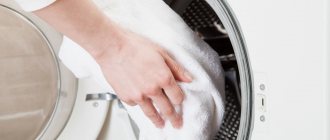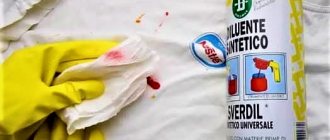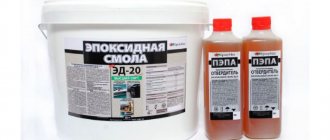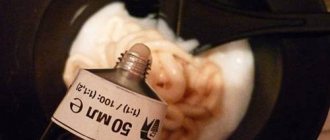- Regular wash
When a paint stain appears on clothing, at first glance it seems that it will be impossible to get rid of. However, you shouldn’t make hasty conclusions; it’s better to get down to business and try to remove the stain before it eats deep into the fibers of the fabric. Let's try to figure out how and what to remove paint from clothes.
Don’t rush to throw away soiled items; in most cases, paint stains can be dealt with using improvised means.
Things to consider
- If the item is expensive and you are afraid to take risks, it is better to immediately take it to the dry cleaner.
- If you want to clean the dirt yourself, don’t delay it. Try to scrub off the paint within the next few hours after the stain appears.
- If the paint has had time to dry thoroughly, first very carefully scrape off the top layer with a blade. This will make it easier to wash it off. But if the fabric is quite delicate, it is better not to use a blade, otherwise you may accidentally tear it.
- All the methods below are working. They have been tested by real people who have shared their experiences on various forums. But very often it is not clear what kind of paint left the mark. Therefore, if the product does not help, perhaps it is simply not suitable for the substance in which your item is stained.
- If the stain is large, you can try several products on it at once in different areas. This way you will know which method will definitely help you. If the stain is small and the chosen product cannot cope with it, just try another one, lightly rinsing off the previous one with water.
- Also test the selected product first on an inconspicuous area of clothing. This will ensure that the color of the fabric is not affected.
- You can rub the product into a rough cloth with any brush or the back of a dishwashing sponge. For delicate stains, it is better to rub it with your hands or clean the stain with the fabric itself, as when washing.
Oil paint
You can try removing a fresh paint stain with cold water and detergent. Pour liquid soap or dishwashing detergent onto the stain, let the mixture soak into the fabric (10-15 minutes), and then try to wipe the paint off with a clean rag.
If the stain has already dried and become ingrained, in order to remove the dye from the clothes, you will first have to lubricate the stain with grease, such as Vaseline, vegetable oil or lard. After the paint has softened, the stains should be cleaned with a brush. After this, solvents can be used.
You can get rid of oily stains left after cleaning the paint with ammonia, heated glycerin or concentrated dishwashing detergent.
Solvents
Acetone
Acetone will help remove oil paint from clothes. Drop a little liquid onto the paint and wait for the product to take effect (5-7 minutes). After the time has passed, you can proceed with normal washing.
Attention! Do not use acetone on colored or acetate fabrics.
Refined gasoline
You can remove paint stains from clothes with purified gasoline. Dampen a cotton swab and gently wipe away any dirt. Wipe the remaining marks with ammonia, and then wash the item with stain remover or laundry soap.
Turpentine
Another solvent, turpentine, can also handle paint stains. Soak a sponge in turpentine and treat the fabric.
After such cleaning, oil stains may remain, which can be removed as follows: line the stain on both sides with sheets of white paper and iron it. If this method does not help, dissolve 1 tsp in a glass of water. detergent, pour onto the stain and scrub thoroughly. You can use liquid soap, dishwashing detergent or shampoo. After the procedure, rinse the fabric in warm water and wash.
You can also remove paint stains from clothes with kerosene, alcohol and ammonia. All of the above products (acetone, gasoline, turpentine) are suitable only for plain fabrics. Do not use solvents for rubberized or stretch materials.
Gasoline + alcohol + turpentine for old stains
Old stains from oil paint can be removed with a mixture of purified gasoline, alcohol and turpentine (in equal proportions). Apply the mixture to the stains and scrub the paint with an old toothbrush. You can soak the stains for 2-3 hours.
Be sure to use gloves when working with solvents
Gasoline + clay (for white things)
A mixture of white clay and purified gasoline will help remove dye from white clothes. Mix the components in equal proportions, apply to the stain and leave for 2-3 hours. Brush off the dried mass and wash the item, additionally using a stain remover.
Gasoline or kerosene (for denim)
For denim, gasoline or kerosene is used. The product is applied to the stain from the reverse side, and a thick cloth is placed under the stain. After 10 minutes, the item is generously rubbed with laundry soap and then washed with powder.
Solvents are not suitable for all types of fabric: before scrubbing the stain, make sure that the material will not deteriorate. Test the product on an inconspicuous area of clothing. Particular care should be taken when handling artificial fabrics.
Vegetable oil (for wool, leather and synthetics)
To remove dye stains from wool, leather, synthetics or cashmere, use vegetable oil: castor, sunflower or olive. A cotton swab is soaked in oil and the stain is treated in a circular motion. Oily marks are removed using a method suitable for the fabric.
If used incorrectly, solvents can irreparably damage the fabric.
Butter and powder (for colored fabrics)
Butter and washing powder will help remove dye from clothes made from colored fabrics. Mix the ingredients in equal proportions and rub into the dirt. Wait 3-5 minutes and wash the stain.
This method is safe for fabrics and effectively removes traces of drying oil-based dyes.
Wash off the oil from leather items with a regular soap solution. Sprinkle stains on wool with talcum powder or starch, then clean off the dried mass and wash the item. Oil traces are removed from silk, nylon and nylon with warm alcohol and then washed in soapy, salted water.
Basic rules for cleaning fabrics yourself
When wondering how to remove paint from clothes, you need to take into account some conditions.
- The faster action is taken, the higher the chance of success.
- When using aggressive liquids, do not rub the stain intensively, as this can damage the fabric structure. The use of gloves is mandatory.
- Processing begins from the inside out.
- To increase washing efficiency, it is best to pre-soak the item.
After cleaning, be sure to wash the item in the washing machine.
Wash off the emulsion
Water-based paint washes off easily. You just need to not hesitate to take action. How to remove fresh paint from clothes? Wash the soiled item with laundry soap. You can throw your clothes in the washing machine and add a good store-bought stain remover and you'll end up with a clean item.
To remove old paint from clothes, first moisten the stain with alcohol. Under its influence, water-based façade paint disappears before your eyes. Does not help? Enhance the effect of alcohol with salt:
- sprinkle the stain with salt (about a teaspoon);
- pour alcohol on top of the salt;
- wait an hour and put it in the machine.
Watercolor, tempera, gouache
Watercolor paint can be washed with cold water and ordinary detergents: powder, gel or liquid soap. Rinse off the paint under a strong stream and soak in cold water with added powder.
Tempera paint is egg- or oil-based and can be a little more difficult to remove stains from. To remove dirt, soak items in cold water with concentrated dishwashing detergent added.
Fresh stains from watercolors and gouache can be washed off with cold water and laundry soap. Soak the item for 15-20 minutes in soapy water and rinse thoroughly
Gouache , which includes an oil and adhesive base, can be cleaned using a solution of ammonia and oxalic acid. Mix the ingredients in equal proportions, apply to the stain and leave for 30 minutes. Then rinse and wash the item.
A mixture of glycerin, ammonia and alcohol (in equal parts) will also help remove paint from clothes. Soak the item in the solution for 30 minutes, rub off the stains, rinse and wash. These methods will help remove stains from simple, thick fabrics such as trousers or jackets.
Features of cleaning different types of fabrics
There are many methods by which you can get rid of paint on clothes. When choosing the right one, you need to take into account a very important factor, namely the type of fabric.
| Fabric type | Removal products |
| Synthetics (polyamide, polyester, etc.) | Do not use aggressive solvents. Gasoline, glycerin, dishwashing detergent, and white spirit are suitable for removal. Wash at a temperature not exceeding 40°. |
| Jeans | Kerosene, gasoline, acetone, tar and laundry soap, dish gel, ammonia. Washing temperature 30-40°. |
| Cotton and linen | The fabrics are natural, so any solvents are suitable: gasoline, kerosene, white spirit, acetone, etc. Wash at 40-60°. |
| Wool, silk and other delicate fabrics | Do not use strong solvents. Soaking is prohibited. Turpentine, vegetable oil, citric acid, and delicate stain removers are suitable. Hand wash at a temperature not exceeding 30°. |
We use butter
Oil paint comes off well with regular butter. Safe for clothing and quite effective . Take a piece of softened and slightly melted butter. Carefully rub the stained areas. Leave it for a while. If the paint is fresh, 5–10 minutes will be enough. It may take a little longer for the stain to dry completely.
Then we take cotton pads or non-woven fabric - whatever is at hand, and carefully erase the stain from the edges to the center until it completely disappears. If necessary, the procedure can be repeated or a mixture of oil and powder can be used as described below.
Rules for removing enamel from clothing
It's easy to remove enamel from clothes if you start washing before the stain dries.
Enamel paints have gained their popularity due to the formation of a durable and smooth protective layer, increased resistance to temperatures and detergents. For operational requirements, such characteristics are always useful, but difficulties often arise in situations where it is necessary to remove enamel from clothing.
First of all, it should be remembered that the enamel contains highly toxic and flammable substances that are quickly absorbed into the fibers of the fabric. The sooner you take action to remove the stain, the higher the chances of saving the affected item of clothing.
If you decide to deal with an enamel stain yourself, without resorting to dry cleaning services, before pouring the first solvent that comes to hand onto the paint, pay attention to the type of material. Thin, delicate fabrics can instantly become completely unusable from their aggressive effects, and instead of a stain, there will be a hole on the pants. To make sure that the product you are using is harmless, pour a few drops of liquid in an inconspicuous place on your clothing, and then feel free to treat the paint stain with it.
After using chemicals to remove enamel paint, do not forget to wash and ventilate your clothes well. Do not use deodorant or perfume to get rid of unpleasant odor.
Review of effective stain removers
If the home option does not help, it would be useful to know how to remove a paint stain using store-bought stain removers.
Bagi 100 types of stains 400 ml
Contains active oxygen
Easily copes with traces of felt-tip pens and paints. Removes fat, blood, juices, etc.
Suitable for all types of fabric
Doesn't remove all old stains
A sharp specific odor remains even after rinsing.
Inconvenient sprayer
Dr. Beckmann Expert Pen and Mascara 50 ml
A special product for removing stains from gel pens, ballpoint pens, pencils, markers, felt-tip pens, paints, and colored inks.
Suitable for any textile products.
Does not contain chlorine and phosphates.
It does not always completely cope with old stains.
High price.
Vanish Gold Oxi Action 450 ml
Contains active oxygen.
Copes with all types of stains (drinks, blood, ketchup, paint, etc.)
Suitable for colored laundry.
Does not contain chlorine.
If it gets on your hands, it corrodes the skin.
Does not always cope with old stains.
ChemiTek Anti-vandal 500 ml
Designed for cleaning hard surfaces, carpets, upholstered furniture, textiles, car seats.
Removes traces of felt-tip pen, marker, ink, certain types of paints, and grease.
Does not have a sharp specific odor.
Udalix Oxi Oltra
Contains active chlorine.
Suitable for colored fabrics.
Does not contain chlorine.
Removes stains from green paint, blood, oils, grass, tar, etc.
Only works on light stains.
Remove it 100 ml
Professional product for removing paint, oil and ink stains on fabrics, clothes, carpets.
Suitable for delicate fabrics.
How not to make a hole: consider the type of fabric
What is the most important thing in fighting stains at home? Don't make a hole in your clothes. Do not overdo it. Do not clean the paint with sharp objects or rub stains too hard. In order not to hopelessly spoil the item, it is important not only to follow the instructions, but also to take into account what the clothes are made of. Learn how to remove stains correctly.
- Made from polyester. The best way is to treat the stain with a mixture of margarine and powder. Methods involving boiling and exposure to high temperatures are prohibited.
- Made from delicate and synthetic fabrics (silk, nylon). Don't experiment. Such materials can easily leave a hole. Solvent liquids are not suitable for removing paint from them. Ammonia will be your salvation.
- From woolen clothes. You cannot remove traces of paint from a coat with alkaline solutions: they damage the wool fibers. Use gentle methods: glycerin, ammonia. First of all, try laundry soap.
- Made from knitwear. You can experiment as much as you like, however, it is important to consider the color of the fabric. Dark material may become lightened by peroxide, while light material may become contaminated by gasoline.
- Made from cotton. A better solution is baking soda, laundry soap, and salt. Acetate liquids should not be used.
- From leather products. Margarine, glycerin, and soap solution will help remove paint stains from a leather jacket. You can use white spirit, but only for genuine leather products. Solvent liquids are not suitable for artificial materials.
Do you doubt your abilities? Take your clothes to the dry cleaner. However, this is not suitable for all fabrics, as can be found on the label.
If none of the methods worked, and you couldn’t remove the paint from your clothes, don’t rush to throw it away. Show your imagination - and the thing will be saved. Any paint mark can be masked. Appliques, stripes, and embroidery will help with this. You can even get creative. This season acrylic brush strokes on clothes are in fashion; they will disguise any “blot”. The recent trend of slits and holes will also come to the rescue. The first option is a salvation for T-shirts, the second will give new life to stained denim shorts.
Dyes used to paint benches and the nuances of their removal
Street benches are mainly treated with oil paint.
This substance is durable. Oil paint leaves corrosive marks on clothes. They may be greasy if greasy paint was used when painting. When removing such dyes from things, it is necessary to take into account the following features:
Oil paints can only be cleaned with strong solvents. Home remedies like baking soda, vinegar, and salt are less effective against such stains.- Oil paint marks are removed better if they are fresh.
Old stains cannot be treated even with strong solvents. It is recommended to wash oil paint from the item in the first hours after the stain appears.
To more effectively remove traces of greasy paint, it is recommended to pre-heat the stained area with a hot iron through a rag.
Latex and acrylic paints
Latex and acrylic paint are easy to wash off while the stain is fresh. Clothes with such stains are soaked in a cold solution of laundry soap. If the stains are difficult to clean, the items are loaded into the washing machine and a long wash cycle is started at a temperature of 30 ℃.
Dried paint can be scrubbed off with a brush using powder or a paste of water and soap shavings. You can use stain removers suitable for the fabric. In the most difficult cases, they resort to solvents: white spirit or purified gasoline.
Gasoline, kerosene, acetone and white spirit are the “heavy artillery”. Use these remedies only in cases where other options have not worked. Remember that there is a very high risk of ruining the fabric.
Paint on jeans - tips for removing paint at home
Butter
Oddly enough, oil paint can be removed with butter. Take 75 grams of butter at room temperature and mix into a homogeneous mixture with 80 grams of washing powder for hand washing.
The resulting paste should be rubbed onto the contaminated area of the product and gently rubbed with a toothbrush. Remove excess with a paper napkin or towel. Apply the mixture again. Cover with film and leave for 30 minutes. First, wash the product with laundry soap by hand, and then load it into the washing machine and wash it with powder.
Table vinegar and ammonia
The combination of ammonia (ammonia) with table vinegar is very effective and 100% effective. It works well with paints that have a water-based (acrylic) base.
To make the mixture you will need:
- fine (or crushed) table salt* – 30 grams;
- vinegar (6 or 9%) – 65 milliliters;
- ammonia (ammonia) – 50 milliliters.
*You cannot use iodized salt - it can burn out the pigment.
A film or plastic bag is placed under the bottom of the contaminated area, and our mixture is laid out on top for 7 minutes. We take a toothbrush and clean it, and if the fabric is delicate, then use a soft cloth. Residues are washed off under running water. Can be washed by hand or machine.
Removing dye from cotton
To remove dye from cotton clothes, prepare the mixture in the following proportion: 1 liter of water, 1 tsp. soda and 100 g of laundry soap shavings. Boil the mixture and immerse the soiled item in the solution for a few seconds. Repeat the procedure until the stain disappears. After this, wash your clothes as usual.
A hot soap and soda solution will help remove any type of dye from cotton items.
Another method: soak cotton for 3-5 minutes in a solution of ammonia (water and ammonia 10:1), and then wash it in the usual way.
Kefir and borax
Borax is a sodium salt of boric acid, which is used in everyday life to remove stubborn contaminants. It can be purchased at any hardware supermarket or pharmacy; the product is inexpensive. Sodium tetraborate not only removes old paint, but also removes stubborn stains from alcoholic and coffee drinks, felt-tip pens, and removes rust.
To prepare an effective composition, take 55 g of borax, 30 g of table vinegar, 75 g of natural kefir with a fat content of 3.2%. Mix all the ingredients so that the product is homogeneous. Apply the solution to the stain and let the mixture dry slightly. Then put cling film over the composition and turn the item inside out. It also needs to be treated with a similar solution. After half an hour, evaluate the result. If necessary, increase the proportion of borax to 75 g.
Useful tips from experts
- Before using any folk or store-bought remedy, test it in an inconspicuous area. Otherwise, there is a risk of damaging the product.
- Do not try to remove the stain using hot water. The paint from such actions only eats into the material more strongly. The water should be at room temperature.
- Fresh traces must be removed immediately, since the dye has not yet had time to be absorbed into the fibers.
- Treatment with chemical compounds should begin from the reverse side of the product.
- If you need to remove dried paint from clothes, take precautions. It is important not to “stretch” the stain and not to “reprint” it onto the back side of the product. Place a clean cloth or paper under the material before cleaning.
If you are not sure that you can get rid of the stain yourself without damaging the product, entrust the task to our specialists. The specialists of our cleaning company know how to remove paint from clothes and how to handle different materials. All the products we use are safe for the environment and your health.
Water-based paint
There are many types of water-based paint and each of them can be washed differently. Sometimes powder and stain remover are enough for washing, in other cases you have to use more serious products.
Water-soluble paints are the easiest to clean
Regular wash
First, try scrubbing the stains by hand using cold water and liquid detergent. If the paint does not work well, proceed to washing in hot water using powder.
Alcohol
You can clean water-based paint stains with alcohol. To do this, you need to stretch the cloth, moisten it with alcohol and rub the stains with a clean rag. The marks should disappear. Do not forget to rinse the item from alcohol and wash it.
Vinegar and ammonia
A special solution will help you remove paint from clothes at home.
Mix 1 tbsp. l. salt, 2 tbsp. l. vinegar and 2 tbsp. l. ammonia. Apply the mixture to the stain and scrub away the dirt with a soft brush. Dissolve the remaining mixture in water and soak the item for several hours. After soaking, wash as usual.
Delicate fabrics (silk, cambric, velvet, etc.) are best cleaned using high-quality and proven stain removers

